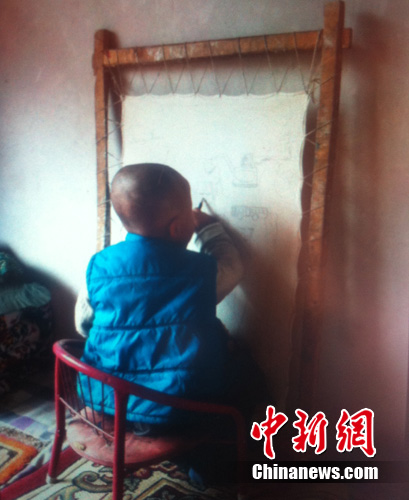The beauty of the Tangka
Tangka-making is rooted in Tibetan culture. These silk paintings, made either by appliqué or embroidery, can be unrolled for appreciation or rolled up for storage. They usually depict a Buddhist deity, famous religious scenario or a mandala of some sort. A tangka work reflects the painstaking labor of its crafter, and the reverence of his soul for Tibetan Buddhism.
A dozen Tangka pieces are exhibited on the walls of the exhibition hall at the Regong Painting Gallery. Wandering among them is a delightful journey through an art form. The vivid characters, delicate brushwork, rich and intense colors, and the three-dimensional nature of the pictures all embody the beauty of Tangka art.
According to the teaching staff here, the painters brush is an instrument chosen with great care. And the paint materials are ground from pearls, minerals, precious stones, coral and gold foil.
Tangka deserves its noble profile, as the works emerge from time-consuming procedures and the skilled use of rare and expensive materials. Sang Douhe, a highly-skilled professional artist, claims that on average he completes only three Tangka works a year. The art demands passionate devotees.
Passion travels
Thangka is an art form passed on from generation to generation, and that too is Regong's mission. Sang Douhe and his family enjoy telling their favorite story about how passionate local residents can be about the regional art form.
Sang Douhe, 48, has devoted 40 years of his life to his artwork. Moreover, his four children followed in his footsteps to become Thangka craftsmen.
It was tradition that only a male could be taught the art, so today female artists are very rare.
Zhuoma, 25, Sang's daughter, is the first female artist in this area. She began to learn from her father at age 13 and only now is able to paint independently.
In Sang's view, feminine qualities can be an asset and an edge in the creative process, and therefore an important addition to traditional Tangka painting. "Some of Zhuo Ma's works are even more popular than mine," admits Sang.
As for Zhuo Ma's small family, her husband is also a professional painter, and their three-year-old son unconsciously imitates his parents, holding a brush to "paint" on the silk.
He may have no idea what he is doing, but the exposure to such an intense artistic atmosphere suggests the little boy has great potential for carrying Tangka painting into the next generation of this family.
"How much did you earn from your painting?" was a key question posed to Sang by the CNS reporter, which got a smile and the brief reply, "A lot." The answer fits the historic and religious depth of the art, and the respect and love it inspires in its practitioners.


















